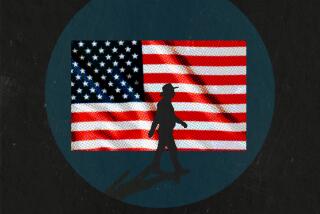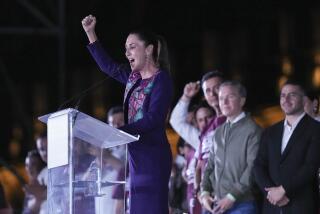A Victory on Cinco de Mayo : Commemoration: Councilman Richard Alarcon succeeds in relating significance of Mexican celebration to young Sylmar students.
- Share via
SYLMAR — Like the uphill battle a ragtag Mexican army faced against a much larger, better-equipped French army 132 years ago, Los Angeles City Councilman Richard Alarcon on Thursday had the tough task of trying to explain the significance of Cinco de Mayo to a group of noisy, fidgety elementary school kids.
And like the small Mexican army in 1862, Alarcon also scored a victory.
“I thought he was pretty good,” said Omar Nevarez, 8, of Sylmar, one of about three dozen students from Hubbard Street and Sylmar elementary schools who attended the celebration at Mission College.
“I think they were paying attention,” said Alarcon, whose 7th District includes Sylmar and most of the northeast San Fernando Valley.
The event at Mission College was one of many planned through this weekend to commemorate the Battle of Puebla, in which 2,000 poorly armed Mexican soldiers defeated 6,000 French soldiers on May 5, 1862. The battle was only a minor setback for the French--who within the year captured Mexico City--but the victory served as a rallying point for Mexico’s freedom.
The celebration of Cinco de Mayo is more popular in the United States than in Mexico, primarily because it was embraced by Chicano student activists in the late 1960s as a symbol of their struggle for civil rights. The students also focused on Cinco de Mayo because it falls late in the school year, which allowed them more time to plan a celebration.
Tonight, a free celebration with music and dancers will be held at Valley College’s Monarch Hall in Van Nuys. On Saturday, a celebration with food, entertainment and prizes will be held at the San Fernando Mall on San Fernando Road from 11 a.m. to 5 p.m.
Thursday’s celebration at Mission College also featured a six-man group called Nazca, which played Andean music. The children stared intently as the rhythmic sounds of flutes, guitars and drums filled the small room on campus.
But Alarcon preceded the musical group, and most of the youngsters were more intent on eating lunch than listening to a politician discuss a subject to which they couldn’t relate.
But Alarcon--who at one point looked down directly in front of him and told two children not to fight over a bag of Cheetos--slowly worked the crowd to get his message across. He started by telling them that at one time no one thought Mission College would be built in the northeast Valley because officials didn’t believe it was needed.
“But we proved that we could make it happen and make it an important place that we use,” Alarcon said as the children sipped milk and chomped apples. “Don’t let anybody tell you you don’t (care about) education.”
He then asked the children if they enjoy going to movie theaters, and where those theaters are located.
“In Panorama City,” said one boy. Another child mentioned Northridge.
“And why don’t we have a movie theater here?” Alarcon asked, having captured the attention of most of the children. Alarcon answered his own question, telling them it is because business owners do not want to invest in an area where there are gang problems and graffiti.
“But,” Alarcon said, building to his message for the students, “just like the Mexican army in Puebla, if you all stand together, you can get what you want. If you promise to get rid of graffiti and not get involved in gangs, I think we can get a movie theater here.”
The children applauded, and Alarcon got his victory.
More to Read
Sign up for Essential California
The most important California stories and recommendations in your inbox every morning.
You may occasionally receive promotional content from the Los Angeles Times.













